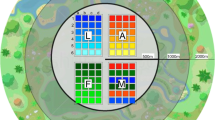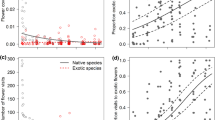Abstract
Urbanisation, associated with habitat fragmentation, affects pollinator communities and insect foraging behaviour. These biotic changes are likely to select for modified traits in insect-pollinated plants from urban populations compared to rural populations. To test this hypothesis, we conducted an experiment involving four plant species commonly found in both urban and rural landscapes of the Île-de-France region (France): Cymbalaria muralis, Geranium robertianum, Geum urbanum and Prunella vulgaris. The four species were grown in four urban and four rural experimental sites in 2015. For each species and each experimental site, plants were grown from seeds collected in five urban and five rural locations. During flowering, we observed flower production and insect–flower interactions during 14 weeks and tested for the effects of experimental site location and plant origin on flower production and on the number of floral visits. The study species had various flower morphology and hence were visited by different floral visitors. The effect of experimental sites and seed origin also varied among study species. We found that (1) insect visits on P. vulgaris were more frequent in rural than in urban sites; (2) for C. muralis, the slope relating the number of pollinator visits to the number of flowers per individual was steeper in urban versus rural sites, suggesting a greater benefit in allocating resources to flower production in urban conditions; (3) as a likely consequence, C. muralis tended to produce more flowers in plants from urban versus rural origin.




Similar content being viewed by others
References
Ågren J, Hellström F, Toräng P, Ehrlén J (2013) Mutualists and antagonists drive among-population variation in selection and evolution of floral display in a perennial herb. Proc Natl Acad Sci 110:18202–18207
Andrieu E, Dornier A, Rouifed S et al (2009) The town Crepis and the country Crepis: how does fragmentation affect a plant–pollinator interaction? Acta Oecol 35:1–7
Baldock KCR, Goddard MA, Hicks DM et al (2015) Where is the UK’s pollinator biodiversity? The importance of urban areas for flower-visiting insects. Proc R Soc B Biol Sci 282:20142849
Bates D, Maechler Martin, Walker S (2016) Package “lme4”: linear mixed-effects models using “Eigen” and S4. CRAN Repos 1–113
Bates AJ, Sadler JP, Fairbrass AJ et al (2011) Changing bee and hoverfly pollinator assemblages along an urban-rural gradient. PLoS One 6:e23459
Biesmeijer JC, Roberts SPM, Reemer M et al (2006) Parallel declines in pollinators and insect-pollinated plants in Britain and the Netherlands. Science 313:351–354
Bischoff A, Müller-Schärer H (2010) Testing population differentiation in plant species—How important are environmental maternal effects. Oikos 119:445–454
Bolker BM, Brooks ME, Clark CJ et al (2009) Generalized linear mixed models: a practical guide for ecology and evolution. Trends Ecol Evol 24:127–135
Brys R, Jacquemyn H (2012) Effects of human-mediated pollinator impoverishment on floral traits and mating patterns in a short-lived herb: an experimental approach. Funct Ecol 26:189–197
Charnov EL (1976) Optimal foraging, the marginal value theorem. Theor Popul Biol 9:129–136
Chouard P (1960) Vernalization and its relations to dormancy. Annu Rev Plant Physiol 11:191–238
Chouard P, Tran Thanh Van M (1962) Nouvelles recherches sur l’analyse des mécanismes de la vernalisation d’une plante vivace, le Geum urbanum L. (Rosacées). Bull Soc Bot France 109:145–147
Clanché F, Rascol O (2011) Le découpage en unités urbaines de 2010. Insee Première 1364:1–4
Deguines N (2015) L’urbanophobie chez les insectes pollinisateurs : apports de l’analyse des données 2010-2012 du programme SPIPOLL. Le Biodiversitaire 6:1–10
Deguines N, Julliard R, de Flores M, Fontaine C (2012) The whereabouts of flower visitors: contrasting land-use preferences revealed by a country-wide survey based on citizen science. PLoS One 7:e45822
Deguines N, Julliard R, de Flores M, Fontaine C (2016) Functional homogenization of flower visitor communities with urbanization. Ecol Evol 6:1967–1976
Devaux C, Lepers C, Porcher E (2014) Constraints imposed by pollinator behaviour on the ecology and evolution of plant mating systems. J Evol Biol 27:1413–1430
Eckert CG, Kalisz S, Geber MA et al (2009) Plant mating systems in a changing world. Trends Ecol Evol 25:35–43
Fontaine C, Dajoz I, Meriguet J, Loreau M (2006) Functional diversity of plant–pollinator interaction webs enhances the persistence of plant communities. PLoS Biol 4:0129–0135
Fortel L, Henry M, Guilbaud L et al (2014) Decreasing abundance, increasing diversity and changing structure of the wild bee community (Hymenoptera: Anthophila) along an urbanization gradient. PLoS One 9:e104679
Gerbault EL (1919) Hérédités chez la Cymbalaire (Première contribution). Bull Soc Linn Normandie 2:111–116
Gerbault EL (1922) Hérédités chez la Cymbalaire (Deuxième et dernière contribution). Bull Soc Linn Normandie 5:3–9
Geslin B, Gauzens B, Thébault E, Dajoz I (2013) Plant pollinator networks along a gradient of urbanisation. PLoS One 8:e63421
Geslin B, Le Féon V, Folschweiller M et al (2016) The proportion of impervious surfaces at the landscape scale structures wild bee assemblages in a densely populated region. Ecol Evol 6:6599–6615
Goulson D (1999) Foraging strategies of insects for gathering nectar and pollen, and implications for plant ecology and evolution. Perspect Plant Ecol Evol Syst 2:185–209
Harder LD, Barrett SCH (1995) Mating cost of large floral displays in hermaphrodite plants. Nature 373:512–515
Harder LD, Williams NM, Jordan CY, Nelson WA (2001) The effects of floral design and display on pollinator economics and pollen dispersal. In: Chittka L, Thomson JD (eds) Cognitive ecology of pollination: animal behaviour and floral evolution. Cambridge University Press, Cambridge, pp 297–317
Harrison T, Winfree R (2015) Urban drivers of plant–pollinator interactions. Funct Ecol 29:879–888
Hernandez J (2009) Ecology of urban bees: a review of current knowledge and directions for future study. Cities Environ 2:1–15
Johnson MTJ, Thompson KA, Saini HS (2015) Plant evolution in the urban jungle. Am J Bot 102:1951–1953
Kirchner F, Luijten SH, Imbert E et al (2005) Effects of local density on insect visitation and fertilization success in the narrow-endemic Centaurea corymbosa (Asteraceae). Oikos 111:130–142
Kotkin J, Cox W, Modarres A, Renn AM (2014) The problem with megacities. Chapman University, Orange
Matteson KC, Langellotto GA (2009) Bumble bee abundance in New York city agriculture. Cities Environ 2:1–12
Matteson KC, Ascher JS, Langellotto GA (2009) Bee richness and abundance in New York City urban gardens. Ann Entomol Soc Am 101:140–150
McKinney ML (2008) Effects of urbanization on species richness: a review of plants and animals. Urban Ecosyst 11:161–176
Pageaud D (2010) L’occupation des sols. In: L’environnement en France. Edition 2010. Commissariat général au développement durable. Service de l’observation et des statistiques, Paris, pp 41–46
Politi Bertoncini A, Machon N, Pavoine S, Muratet A (2012) Local gardening practices shape urban lawn floristic communities. Landsc Urban Plan 105:53–61
Potter A, LeBuhn G (2015) Pollination service to urban agriculture in San Francisco, CA. Urban Ecosyst 18:885–893
QGIS Development Team (2015) QGIS geographic information system. Open source geospatial foundation project. http://qgis.osgeo.org. Accessed 22 Sept 2017
R Core Team (2016) R: a language and environment for statistical computing. R Foundation for Statistical Computing, Vienna, Austria. https://www.R-project.org/. Accessed 22 Sept 2017
Seto KC, Güneralp B, Hutyra LR (2012) Global forecasts of urban expansion to 2030 and direct impacts on biodiversity and carbon pools. Proc Natl Acad Sci 109:16083–16088
Seto KC, Parnell S, Elmqvist T (2013) A global outlook on urbanization. In: Elmqvist T, Michail F, Goodness J et al (eds) Urbanization, biodiversity and ecosystem services: challenges and opportunities. Springer, Netherlands, pp 453–459
Threlfall CG, Walker K, Williams NSG et al (2015) The conservation value of urban green space habitats for Australian native bee communities. Biol Conserv 187:240–248
United Nations (2014) World urbanization prospects: the 2014 revision. United Nations, New York
Ushimaru A, Kobayashi A, Dohzono I (2014) Does urbanization promote floral diversification? Implications from changes in herkogamy with pollinator availability in an urban–rural area. Am Nat 184:258–267
Weiner J, Martinez S, Muller-Scharer H et al (1997) How important are environmental maternal effects in plants? A study with Centaurea maculosa. J Ecol 85:133–142
Zuur AF, Ieno EN, Elphick CS (2010) A protocol for data exploration to avoid common statistical problems. Methods Ecol Evol 1:3–14
Acknowledgements
This study was financially supported by the Mairie de Paris. We would like to thank Jacqui Shykoff, Bernard Vaissière, Nathalie Machon, Mathilde Baude and Sandrine Pavoine for their insightful comments and discussions. We are grateful to land managers for allowing us to set up our experiment on their sites, particularly David Otamendi, Aubin Garcia (CIUP, Paris), Philippe Barré (Jardin Ecologique, MNHN, Paris), Pascale Evrard (Jardin “Le VerTêtu”, Paris), Karina Prévost (Jardin potager, Parc de Bercy, Paris), Alexandre Mari (PNR Haute Vallée de Chevreuse), Amandine Hansart and Beatriz Decencière (CEREEP Ecotron, Foljuif) and Céline Riauté (Campus Orsay). Many thanks to Eric Motard, Xavier Raynaud and Gwendoline Grandin for their help with seed collection. We warmly thank Alexandra Cerqueira de Araujo, Esther Debray, Jamie Lozoff, Jan Perret, Lucie Berthon, Jean-Baptiste Bonnin, Yannick Poyat and Alexia Garrido for their help during field work.
Author information
Authors and Affiliations
Corresponding author
Ethics declarations
Funding
French ministry of research, and the Ville de Paris.
Conflict of interest
The authors declare that they have no conflict of interest.
Electronic supplementary material
Below is the link to the electronic supplementary material.
Rights and permissions
About this article
Cite this article
Desaegher, J., Nadot, S., Dajoz, I. et al. Buzz in Paris: flower production and plant–pollinator interactions in plants from contrasted urban and rural origins. Genetica 145, 513–523 (2017). https://doi.org/10.1007/s10709-017-9993-7
Received:
Accepted:
Published:
Issue Date:
DOI: https://doi.org/10.1007/s10709-017-9993-7




